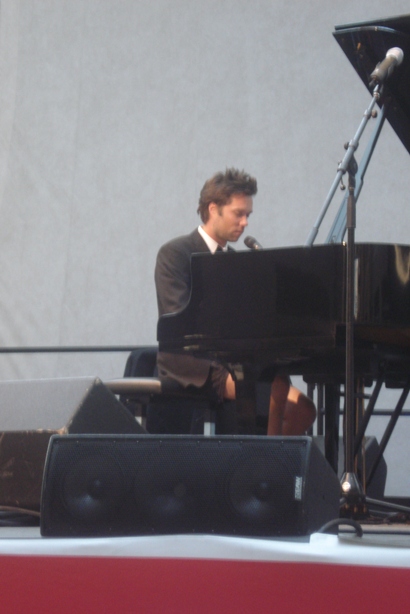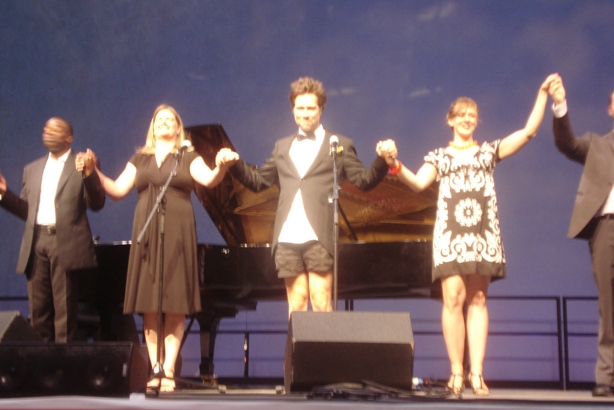Rufus Wainwright and the New York City Opera, 6/28/11
In the presence of beautifully polished marble floors, majestically tall columns and palm trees (I’ll get to this later), I watched an artistic endeavor unfold. Rufus Wainwright – songwriter extraordinaire – joined forces with the New York City Opera to showcase some of the pieces from his upcoming opera, Prima Donna. The free concert, part of the River to River Concert Series, was set in the World Financial Winter Garden, hence the palm trees. The atmosphere had elements of sophistication and simplicity, so it only made sense that Rufus Wainwright strutted – and I do mean strutted- out on the stage in flip flops, shorts and a tuxedo jacket.

As stated by the emcee, Rufus is “a perfect bridge between opera and pop music.†Even though Rufus, as he so eagerly told the audience, has been listening to opera music since a young age, he was not pretentious with his opera knowledge; he prefaced each opera song with a short (and sometimes slightly inaccurate, as the gentleman behind me who quietly corrected one of Rufus’ spotty translations can attest) synopsis. His laymen terminology and laid back demeanor put the audience and the performers at ease, allowing us all to more readily participate in the fusing of two music mediums.
Rufus opened the show with one of his own pop songs entitled “Damned Ladies,†a melancholy, contemplative piece that is classically “Rufus†with its use of chromatics and elongated, indulgent notes. Barring a few sassy tosses of his hair, Rufus’ demeanor stayed true to the sober tone of the song. He expertly engaged the audience with his unique voice and his not-so-quiet confidence, taking liberties with the dynamics and the tempo, keeping even a well-known song unpredictable.

“Dans mon pays de Picardie,†a piece from Rufus’ not yet staged French Opera Prima Donna, was beautifully performed by soprano Anne-Carolyn Bird. She deftly maneuvered the obligatory glissandos and sustained high notes with ease while Rufus sat on the side of the stage, locked in a reverie, enjoying the product of his work. While the vocal line was infused with the customary opera requirements, the piano line was steeped in Rufus’ signature grand style. The piece sounded like a more musically sophisticated and complex French pop song; and while some opera purists may balk at Rufus’ fusion of mainstream and classical music, most listeners are sure to be intrigued.
“Vibrate,†a lingering and enchanting not-so-typical ballad from Rufus’ Want One album, was a perfect song choice due to the fact that its piano lines sound quite similar (as my friend so smartly noted) to the piano line in the famous Carmen song “Seguidilla,†which was sung earlier in the evening by mezzo-soprano Laura Vlasak Nolen. As Rufus crooned through the memorable lyrics “my phone is on vibrate for you,†his voice oozed longing and the audience collectively pined away with him.
Rufus did indeed succeed (at least with this particular audience) in his enterprise to bridge the gap between classical and pop music. Imparting his own dramatic flair and brilliant songwriting skills into a typically less-approachable genre such as opera, he hopes to merge these two musical art forms. And if anyone can accomplish this feat, it is Rufus.


One Trackback